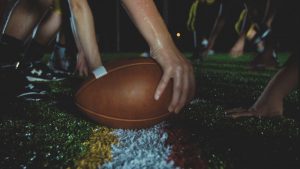How to Remove Stains from Artificial Turf
The following are some general suggestions for cleaning and removing stains from your synthetic turf. If at any time you are unsure please reach out to us for assistance.
GENERAL
Polyethylene pile fibers are among the most stain-resistant fibers. Most “stains” on Sporturf™ fields are not true “stains” but rather residues of foreign matter that must be promptly and thoroughly removed.
Such “stains” on wet fields can be removed with water or soap and water. The first rule is promptness. It is much easier to clean up a fresh spill before it has time to dry and harden. Remove any solid or putty-like deposit promptly using a dull knife or spatula-like tool. Blot up excess liquids with a stack of towels, cloth, or paper. Dry absorbent clay-based materials; such as kitty litter absorbers can be very useful and should be stored on site. Such dry absorbers can be swept or vacuumed up.
PROCEDURE FOR REMOVING “STAINS” AND OTHER BLEMISHES
A. “Water-Borne” Residues
Most “stains” commonly associated with playing fields can be classified as “waterborne” stains. These stains are best removed using a warm, mild solution of granular household detergent (nonabrasive).
TYPICAL WATERBORNE “STAINS”
Acid, Alcohol, Alkali, Ice Cream, Latex, Paint, Milk, Urine, Water, Colors, Fruit Juice
1. Brush the residue with a stiff fiber brush.
2. Scrub the area with soap and water.
3. Rinse the area thoroughly with clear water to remove all traces of soap.
4. Dry with an absorbent towel, if necessary.
A three percent solution of ammonia in water may be used in lieu of household detergent for more stubborn residues or stains.
B. Persistent or Oil-Based Stains
Follow the directions below:
PROBLEM: Crayon, furniture stain, lipstick, metal polish, cooking oil, rubber cleat marks, shoe
polish, suntan oil, ballpoint ink
PROCEDURE: Sponge with perchloroethylene (dry cleaning solution). Blot with absorbent towels.
PROBLEM: Oil paints
PROCEDURE: Blot immediately. Sponge with turpentine or paint remover (apply sparingly).
Blot with detergent and water. Re-sponge with cold water. To remove detergent. Scrape excess. Sponge with perchloroethylene (dry cleaning solvent). Repeat steps as necessary.
PROBLEM: Nail Polish
PROCEDURE: Sponge with acetone.
PROBLEM: Paraffin Wax
PROCEDURE: Scrape excess. Sponge with perchechlorethylene (dry cleaning solvent).
PROBLEM: Tar and Asphalt
PROCEDURE: Scrape excess. Sponge with perchechlorethylene (dry cleaning solvent).
Caution!!
Mineral spirits and other petroleum-based solvents are highly flammable. Do not smoke or permit open flames near container or near solution when in use. Be sure the area is well ventilated.
C. Animal Waste
Neutralize with a mixture of white distilled vinegar in an equal amount of water. Flush
thoroughly with water after application. An enzyme type of cleaner is also effective.
D. Chewing Gum
Spray with Freon and scrape to remove residue (available in aerosol packs from carpet cleaning suppliers- or use dry ice).
E. Fungus, Mold Spots or Moss
Use Game Plan 4 Turf® at a rate of 1 gallon of concentrate per 11 gallons of water to cover 12,000 sq/ft. and spray thoroughly. Do not use a high-pressure water spray with stream force in excess of 2500 PSI as this can severely damage the turf. Game Plan 4 Turf® is an EPA-registered disinfectant. Mr. Clean and Vital Oxide perform as needed but have not been EPA approved.
As always if you have any questions or concerns please contact your respective Account Manager before proceeding. They are a valuable resource.

